The Museum Collections
Introduction
I. History and Art Collection
1. Icons of the 14th – 19th centuries
icons of the 14th – 17th century
2. Jewelry art of the 14th – 20th century
jewelry art of the 14th – 17th century
jewelry art of the 18th – 19th century
the european silver 14th - 19th centuries
3. Small-size sculptures (works of metal, wood, bone)
XI – the beginning of the XX century
Small-size sculptures 11th – 17th century
Small-size sculptures 18th – early 20th century
enamel of Troitza masters 15-8th – early 20th century
5.Embroidery, lace, textiles of the 14th - early 20th century
icon and ornamental embroidery
gold and silver lace
6.Painting of the 18th – 21st centuries
painting of the 18th – 19th centuris
painting of the 20th – 21st centuris
II.Manuscripts and old printed books of the 14th – 17th century
IV.Lithography of the 18th – 19th century
V.Numismatics
VI.Medals of the 18th - early 20th century
VIII.Archeology collection
IX. Russian folk and applied and decorative art of the 17th – 21st c.
1. Artistic wood
folk carved and painted wood
wooden toys
house carving of Sergiev Posad
Khokhloma and Gorodets painting
2. Artistic textiles
embroidery and weaving
printed textiles and lace
Russian shawls
folk costumes
folk garments
printed cotton kerchiefs
|
Jewelry Art of the 14th – 17th cc. (page 4)
|
The gold cross-reliquary was made in the workshops of the Armoury Chamber in 1678 to the order of Grand Princess Irina Mikhailovna and brought to the Monastery by Tsar Feodor Alexeyevich according to the inscription on the cross and the record in the Book of Donations of 1639. Enamel matched perfectly decorativeness and festivity of the 17th century applied art. Russian craftsmen could use in various ways. At the second half of the 17th century enamel frequently covered the whole figures of saints on different church objects. The small gold icon of 1667 with the enameled image of St. Sergius of Radonezh, donated by Boyar Bogdan Matveyevich Khitrovo, is a characteristic example.
Various enamels used in decoration of the luxurious cover of the printed Gospel, presented by Prince I.B. Repnin in 1695. The multi-colored painted floral ornament, framing the oval burs with pinkish-lilac Chinese stones with relief images – the Saviour Enthroned in the center and Evangelists in the corners of the gilded silver board. Blue and green champleve enamel covers the wings of chased cherubs around the central image. Multi-colored enamel fills the filigree pattern of silver figured plaques on the gold background of the back board of the cover.
|
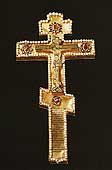
Cross-reliquary. 1678. Donated by Grand Princess Irina Mikhailovna |
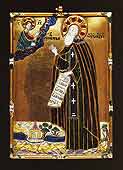
Icon. St. Sergius of Radonezh. 1667. Donated by Bogdan Matveyevich Khitrovo |
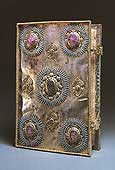
Gospel. 1695. Donated by Prince Ivan Borisovich Repnin |
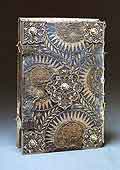
Gospel. 1695. Donated by Prince Ivan Borisovich Repnin. Back cover
|
Russian church and secular utensils of XVII century still keep traditional forms. However, in comparison with previous century their decorative furniture more richly. Quite often, their all surface decorated by the dense stamping or engraved ornament. Fine representation about such vessels gives “bratina”, enclosed in a monastery in 1633 by tsar’s clerk Feodor Apraksin. Along with the magnificent, elegantly decorated products in XVII century meets much and such where masters still prefer ancient traditions in processing of the form and revealing of features of a material. In addition, in this case separate elements of their decor eloquently testify to a spirit of the age.
Such is the massive forged sacred water’s
bowl from silver, custom-made of Alexander Bulatnikov, cellarer of a monastery, in 1631. In an antiquity were appreciated very rare products from nacre and various ornamental stones. There are presents unique cups from nacre, small cups from onyx and cornelian. Their decorative qualities are in many respects defined by already materials which natural beauty become known even more brightly in a combination to skilful silver and gold frames. The cup concerns the rare products from a jasper, put in order by the stamping gilt silver, enclosed by cellarer of the monastery Simon Azaryin in 1650. The cover of the cup finished by a cast man's figure, probably, the West European work.
|
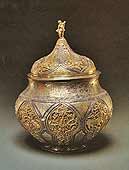
“Bratina”. The 1-th third 17 c. Donated by Feodor Nikitich Apraksin |
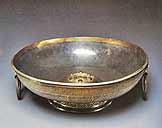
Sacred water’s bowl. 1631. Donated by Alexander Bulatnikov |
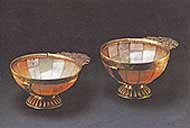
Cups. 17 c. Belong to Leontiy Levshin |
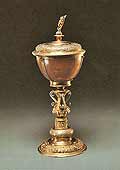
The bowl. 17 c. Donated by Simon Azaryin
|
|


